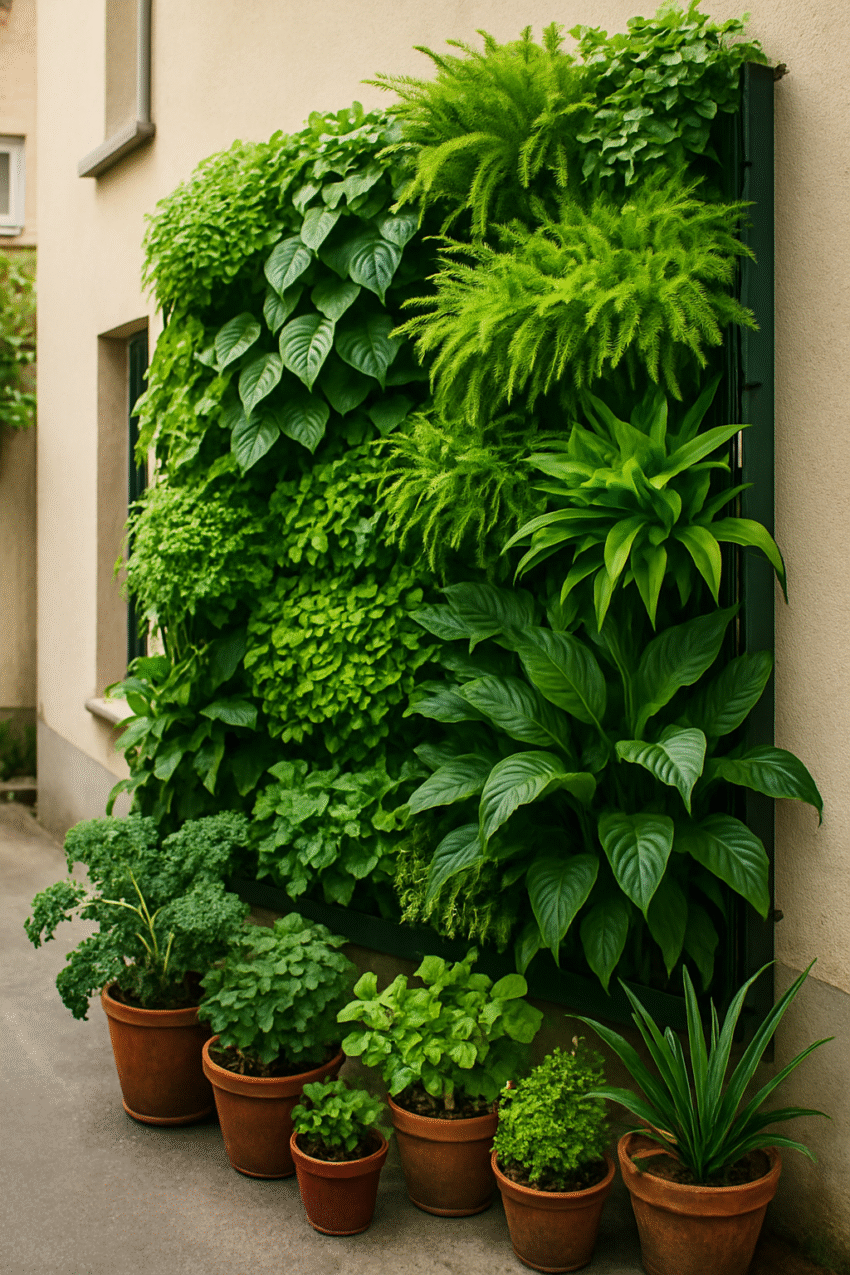If you’ve ever stared at your tiny backyard, cramped apartment balcony, or even just a bare wall and thought, “I wish I had room for a real garden,” I’m here to tell you — you absolutely do. Vertical gardens are the smart, stunning solution that’s letting people grow lush, productive gardens in the smallest spaces. From what I’ve personally seen, with just a little creativity and the right setup, you can grow big — really big — even when your square footage is tiny.
Introduction
Gardening used to mean needing a large plot of land, long hours of backbreaking labor, and seasons of patience. Not anymore. Thanks to vertical gardening, even city dwellers living in compact apartments can enjoy fresh veggies, fragrant herbs, and beautiful flowers right at home. It’s efficient, it’s beautiful, and best of all, it fits just about anywhere.
Let me walk you through everything you need to know about vertical gardens: what they are, why they’re taking off, how to create one, and why you might never look at your walls the same way again.
What Is a Vertical Garden?
In the simplest terms, a vertical garden is a method of growing plants upwards rather than outwards. Instead of traditional flat beds, plants are supported by structures like trellises, shelves, towers, or even specially designed wall panels.
In my experience, a vertical garden isn’t just about saving space — it’s about maximizing potential. I’ve seen setups where people grow tomatoes, strawberries, and even squash in spaces smaller than a closet door. Whether indoors or outdoors, vertical gardening lets you harness walls, fences, and tiny patches of unused space to grow real, thriving plants.
Common Structures Used in Vertical Gardening:
-
Trellises
-
Hanging pockets
-
Stackable planters
-
Wall-mounted frames
-
DIY pallets and recycled materials
The beauty is you can get as creative — or as simple — as you like.
Why Are Vertical Gardens Becoming So Popular?

There are a few undeniable reasons why vertical gardens are exploding in popularity — and trust me, it’s not just because they look Instagram-worthy.
Space Efficiency:
This one’s obvious. From balconies to kitchen walls, vertical gardens make use of overlooked vertical real estate.
Urban Gardening Solutions:
More people than ever are living in cities. In fact, according to the UN, over 55% of the world’s population lives in urban areas, and that number is only rising. Vertical gardening offers a way to stay connected to nature even in a concrete jungle.
Aesthetic Appeal:
Nothing warms up a space quite like greenery. From rustic setups with repurposed wood to sleek, modern plant walls, vertical gardens add beauty and life to any environment.
Better Air Quality:
Indoor vertical gardens can significantly improve air quality. NASA research shows certain plants can filter out toxins like benzene and formaldehyde.
Ease of Maintenance:
With smart designs, vertical gardens often require less bending, less weeding, and easier watering.
Honestly, once you start seeing the benefits, it’s hard to imagine why you’d ever stick with flatbeds only.
How to Start Your Own Vertical Garden
Starting a vertical garden might sound intimidating, but let me tell you — it’s much easier than you might think. I’ve set up a few myself, and once you get the hang of it, it’s addicting!
1. Choose Your Location
First things first: where are you putting it? Indoors or outdoors? Sunlight access is key, so observe the light patterns throughout the day. If you’re limited on sunlight, opt for plants that thrive in low-light conditions.
2. Pick Your Structure
Depending on your budget and style, you can choose:
-
A ready-made vertical gardening system
-
DIY options like old pallets, shoe organizers, or hanging baskets
-
Wall-mounted shelves or racks
From my own projects, I’ve found that even a simple, sturdy shelving unit can become a lush oasis with the right setup.
3. Select the Right Plants
Not all plants love vertical living equally. Here’s what I recommend for beginners:
-
Herbs: Basil, mint, thyme
-
Leafy greens: Lettuce, spinach, arugula
-
Vining plants: Tomatoes, cucumbers, beans
-
Flowers: Petunias, nasturtiums, marigolds
Start simple, and as your confidence grows, expand your variety!
4. Set Up Proper Watering
Vertical gardens dry out faster than traditional ones. Drip irrigation systems or self-watering containers can be lifesavers here. In my early setups, I used recycled water bottles with slow-drip setups — cheap, easy, and very effective.
What Are the Best Plants for Vertical Gardens?

Choosing the right plants is half the battle when it comes to vertical gardening success. Based on my experience and what experts recommend, here are some top picks:
Best Edible Plants:
-
Strawberries – Sweet, compact, and perfect for hanging pockets.
-
Cherry Tomatoes – Fast-growing and prolific.
-
Lettuce and Spinach – Lightweight and shallow-rooted.
-
Peppers – Hot or sweet varieties thrive vertically with support.
Best Ornamental Plants:
-
Ferns – Love the shady nooks.
-
Succulents – Require minimal water and look stunning.
-
Trailing vines (like pothos or ivy) – Add that lush, cascading look.
Pick plants that fit your lighting, climate, and care preferences for the best success.
How to Maintain a Vertical Garden
If there’s one thing I always emphasize when coaching new gardeners, it’s this: maintenance matters. A little routine care keeps your vertical garden thriving year-round.
Key Maintenance Tips:
-
Water Regularly: Especially in hot weather, small containers dry out fast.
-
Feed the Soil: Use a liquid fertilizer every few weeks to keep nutrients up.
-
Prune and Harvest Often: This encourages new growth and prevents overcrowding.
-
Inspect for Pests: Small, tight spaces can attract bugs like aphids — catch them early!
In my own vertical gardens, a five-minute daily check-in routine works wonders. Trust me, a few minutes a day beats trying to rescue a dying wall of plants later!
Creative Vertical Garden Ideas for Tiny Spaces
Feeling inspired but still wondering where to start? Let me throw some creative ideas your way:
-
Living Wall Art: Install a frame with succulents for a stunning “green painting.”
-
Upcycled Pallet Garden: Turn an old pallet into a rustic herb or flower garden.
-
Hanging Gutter Gardens: Use old rain gutters to create layered rows of plants.
-
Shoe Organizer Gardens: Hang a fabric shoe organizer, pop plants into the pockets, and you’re done!
-
Tower Planters: Stack pots in a spiral tower — great for strawberries and greens.
Honestly, once you start thinking vertically, your options are endless.
Conclusion
I can honestly say that discovering vertical gardening changed how I think about growing plants — and how much greenery I can fit into my everyday life. Whether you’re a seasoned gardener or a complete beginner, vertical gardens offer an exciting, beautiful, and practical way to grow big, even when your space is tiny.
If you’ve been dreaming of fresh herbs by your kitchen window or a vibrant wall of flowers on your balcony, there’s no better time to start than now. Grab a few supplies, pick your plants, and start growing upward — your future garden (and your tastebuds) will thank you.
Ready to start your vertical garden adventure? Drop your questions or share your first setup with me in the comments — I’d love to hear how you’re growing big in your small space!
